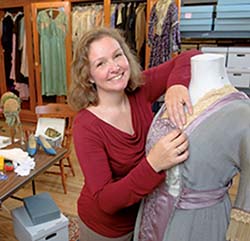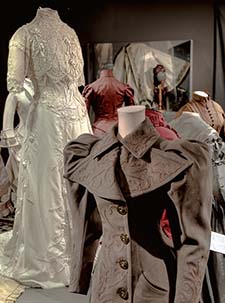 |
 |
| current issue |  | past issues |  | send a letter/news |  | address update |  | advertise |  | about us |  | alumni home |
Features
|
Say Yes to the Dress
Victorian women put their own spin on the power suit. |
Easy to print version |
 Lisa Nugent/UNH Photographic Services |
The Victorian ladies of UNH have gathered for a chat. They mill about on risers in a ground-floor room at Dimond Library, facing in all directions as they display their finery from perfectly pleated collar to elegantly draped bustle. They are a fashion show, a three-dimensional swatch of history, and a testament to the tough-minded long-ago instructor who brought them together.
The ladies are headless, yet they speak. And through the contemporary women who channel their voices, this is what they say: Do not underestimate us. You'd be amazed what we can do in these corsets.
Now listen more closely. Explore the display cases on the walls of the UNH Museum, and the shelves and cupboards of its storage area down the street, and you'll hear a tiny plea: Time is the enemy. Help us.
The ladies of the museum's "Embellishments: Constructing Victorian Detail" exhibit are not flesh but foam. They are mannequins custom-carved for each outfit by guest curator Astrida Schaeffer '99G, a costume historian whose life changed when she began listening to the tales textiles tell. "Good morning, ladies," Schaeffer says as she flips on the light in their room. She sees each garment as a woman with a story, and the stories together as a window into history.
Dale Valena '04, curator of the UNH Museum, shares Schaeffer's belief in the power of objects to bring history to life. "The more our lives become virtual, the more precious physical things become," Valena says. The library's Special Collections department preserves the documents that tell New Hampshire and UNH stories. The museum preserves the objects, including the 600-piece Irma Bowen Textile Collection, from which Schaeffer chose the dresses for "Embellishments."
The exhibit's particular slice of history is the Victorian era of the 19th century, when Queen Victoria defined taste on both sides of the Atlantic. Take, for instance, the white wedding dress, something rarely seen before Victoria wore white lace to marry Prince Albert in 1840. When that fashion news made its way to the United States, every woman of means suddenly wanted a wedding dress in a color nearly guaranteeing that she'd wear the dress only once.
 Lisa Nugent/UNH Photographic Services |
Most of the women whose clothes wound up in the collection could not claim membership in that privileged class; they would have considered a one-day-only wedding dress the height of profligate spending. Their donated clothes, from housedresses to formal gowns, arrived on campus between the 1920s and 1940s in response to a request from Bowen, who wanted a hands-on way for her home economics students to study garment construction. People around the area brought her what they or their mothers or grandmothers had saved.
"Clothing that has been stored as a memento is a snapshot of the socially sanctioned norms of its day," Schaeffer says. "These garments tell stories." Sometimes she finds the stories through documents, especially if a family was prominent. An intricately gathered and pleated maroon silk dress in the exhibit, for example, belonged to the grandmother of former Gov. Walter Peterson. Family lore says it was her wedding dress.
Around 1890, Johanna Peterson "spent a good bit of money on that garment," Schaeffer says. She probably expected it to serve as not just her wedding dress but also her "best dress" for years. "I look at this dress," Schaeffer says, "and I see a young woman who wants to present herself a certain way to her new world: 'This is who I am and who I hope to be.'"
When a donation is not well-documented, Schaeffer launches her own version of "CSI." Call it Costume Science Investigation, methodically asking the fabric to surrender its truths. One elaborate dress is a knockout—brown and tan silk taffeta, each trimming the other in every combination of bow and band and pleat, so that the finished product looks far more sumptuous than a dress in two neutral colors has any right to look. The donation information said it was a wedding dress worn by a particular woman in 1850. But Schaeffer's research showed that the woman would have been too old for the dress's trendy style and trim contours. Additional sleuthing revealed more clues—placement of darts, construction of sleeves—that placed the dress firmly in the 1880s.
Scratching the surface of clothing to discover its secrets excites Schaeffer the way scratching a ticket to find a winning lottery number would excite someone else. Wandering the exhibit, she stops at a walking dress whose fabric, blue velvet woven onto a red ground, seems to glow from within, even after 120 years. Pure luxury—or so it appears. "But look!" Schaeffer says. She shows how the dressmaker used just enough velvet at the top for the dress to seem to have a jacket, and just enough at the bottom so it could pretend to have a full velvet underskirt.
Easy to print version
blog comments powered by Disqus

